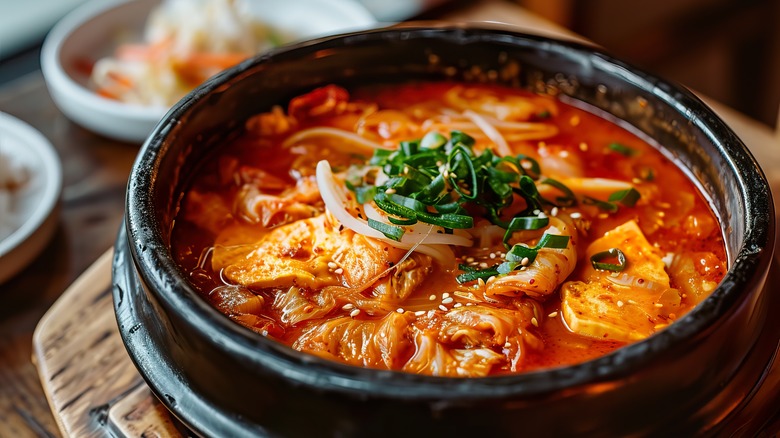To Fix Kimchi That's Too Salty Just Add One Ingredient
Over-salted kimchi is a buzzkill. After all that chopping, brining, and fermenting, it's a real bummer when you try that first homemade morsel and it's too salty for your tastebuds to tackle. Luckily, you can fix the problem by adding one ingredient: radish.
A classic kimchi is a mix of crisp vegetables fermented with seasonings, like spicy gochugaru or gochujang, and salt. The salt is vital to the pickling process because it does three things. Firstly, it draws out the moisture in the cabbage, which creates the scrumptious brine it steeps in. Secondly, it lends the vegetables heaps of flavor. Thirdly, and most importantly of all, it preserves the veggies by hampering the growth of some bacteria but allowing others, like lactobacillus, to thrive, which gives fermented foods their telltale tang.
Radish dilutes the salinity of over-salted kimchi by absorbing the excess salt. Plus, it has a satisfying crunch and a peppery flavor to boot. Virtually any variety of radish will work from small pink radishes that have a spherical or tear drop shape to large white daikon (also known as mooli), a popular garnish for sashimi. All you need to do is chop your radish into slices or batons and add it to your kimchi to temper its saltiness (allowing at least 24 hours for it to work its magic). However, if you don't want to eat the radish, chop it into hefty disks, stir it through your jar and discard the chunks once they've absorbed the extra salt.
Use over-salted kimchi to flavor a kimchi stew
Another fuss-free move that can help to curb the salty hit of homemade kimchi is to allow it to ferment for longer in your kimchi container. While this doesn't remove the salt, it does intensify the flavor of the cabbage as it pickles (it may just need a little extra time to hit that sweet spot and reach the right balance). If this trick doesn't work, then consider stirring your kimchi through cooked rice to create a spicy, salty side to serve with grilled meats. You can also attenuate the brackish quality of your over-salted kimchi by using it to make Kimchi-jjigae, a flavorful stew made with diced tofu, pork and scallions.
If you find that you enjoy the flavor of the radish in your kimchi, consider making your next batch entirely of radish and skipping the cabbage altogether. Known as kkakdugi, this variety of kimchi is common in Korea and has a mildly peppery, almost refreshing character. The fermentation process tempers the inherent spiciness of the radish and brings its natural sweetness to the fore. The radish also has enough moisture in it to create its own lip-smacking brine with the addition of salt, sugar, and gochugaru.

